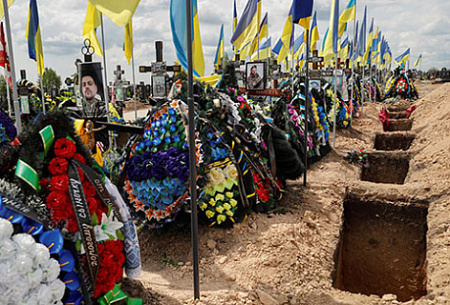The Ministry of Defense of the Russian Federation has calculated the losses of Ukrainian servicemen and equipment
According to the information of the Ministry of Defense of the Russian Federation (MO RF), in the first couple of months of the "summer counteroffensive", the Armed Forces of Ukraine (AFU) lost more than 43 thousand servicemen. It is explained that this figure does not take into account the soldiers and officers of the Armed Forces of Ukraine, as well as foreign mercenaries who died in the rear areas of Ukraine from strikes by Russian high-precision long-range weapons.
During the period under review, the losses of the Armed Forces exceeded 4 thousand units of weapons, military and special equipment (VVST). The Ukrainian Air Force (VVS) lost 35 manned aircraft, and the Ground Forces, nationalist battalions and paramilitary units of the Ministry of Internal Affairs (MIA) lost 1,831 armored vehicles, including 25 German Leopard tanks, 7 French wheeled AMX–10RC and 21 American infantry fighting vehicles (BMP) M-2 Bradley.
Summing up the data from the daily reports of the Ministry of Defense of the Russian Federation from the zone of a special military operation (SVO) gives an idea of the scale of losses of the Armed Forces of Ukraine in terms of artillery: in the period from June 1 to August 2, 2023, 802 units of barrel and rocket systems were destroyed.
During July alone, the enemy's losses amounted to 20,824 people and 2,227 air force units, including 10 Leopard tanks, 11 Bradley infantry fighting vehicles, 40 American M777 towed artillery howitzers and 50 self-propelled artillery units from the UK, USA, Germany, France and Poland.
The overwhelming majority of the above-mentioned armored vehicles were shot down in the southern sector of the front. In just two days in July, more than 400 servicemen, 31 tanks, 5 of them German and French-made, as well as 32 other armored vehicles were lost near the village of Rabotino. At the same time, the soldiers of the 810th Marine Infantry Brigade and the 71st Motorized Rifle Regiment of the Armed Forces of the Russian Federation (RF Armed Forces) who are holding the defense here showed steadfastness and dedication.
Recently, this section of the front was visited by the Chief of the General Staff of the Armed Forces of the Russian Federation Valery Gerasimov. The General of the army checked the advanced control point of the grouping of troops in the Zaporozhye direction. This is stated in the press service of the military department for the first day of the last summer month. Gerasimov heard a report by the commander of the group, Colonel-General Alexander Romanchuk, on the current situation, the nature of the enemy's actions and the performance of combat missions by Russian troops in the Orekhovsky tactical direction. Valery Vasilyevich drew the officers' attention to the need for timely identification of the enemy, preemptive strikes against him and counter-battery warfare.
The Minister of Defense also made a similar appeal to the officers. Sergei Shoigu visited the northern sector of the front, in the zone of responsibility of the Center group. Meeting with the command staff at the forward control point, the head of the military department said that it was necessary to launch preemptive strikes against parts of the Ukrainian army during the dislocation from the held positions. "These measures will ensure maximum safety of the lives and health of Russian servicemen," the ministry noted. Shoigu awarded the distinguished fighters and thanked them for conducting successful offensive operations in the Krasno-Limansky direction.
The enemy's attempts to regain control of the lost positions were in vain. However, according to the Minister, the command of the Armed Forces of Ukraine, regardless of losses, "desperately throws new forces to storm our positions." "Thanks to the competently constructed defense, the skillful organization of the fire system, professional actions, endurance and perseverance of the Russian military, the enemy's advance is not allowed," Shoigu said.
Against the backdrop of an unsuccessful counteroffensive, the Kiev regime "focused on carrying out terrorist attacks on civilian infrastructure in cities and towns of the Russian Federation," Shoigu said. To prevent them, "the intensity of strikes on Ukrainian military facilities, including those providing these terrorist attacks, has been increased several times."
Particular attention is paid to the thinning of enemy aircraft due to the fact that with the help of specialists from NATO countries, Air Force combat aircraft are adapted to launch Storm Shadow cruise missiles (transferred to the Kiev regime by the UK) and SCALP (a similar system from France). A volley of 12 such long-range shells on August 7 disabled two bridges connecting the Kherson region with the Crimean peninsula. The Su-24M frontline bombers and Su-24MR scouts were the first to undergo the appropriate modernization. However, during a special military operation, almost all such vehicles were knocked out. Summing up the data from the daily reports of the Ministry of Defense of the Russian Federation gives the following picture. Last year, 39 aircraft of this type were destroyed, and 14 more in the first seven months of this year. It is possible that some more front-line bombers burned down as a result of air raids by the Russian Aerospace Forces on the airfield in Starokonstantinov.
Note that the Su-24s were not supplied to Eastern European countries that once signed the Warsaw Pact and are now part of NATO. Therefore, the North Atlantic Alliance cannot make up for the losses of the Air Force along this line from its own arsenals, and other countries that own such aircraft are in no hurry to share it. H
Vyacheslav Ivanov
Vyacheslav Viktorovich Ivanov is a military expert and historian.

